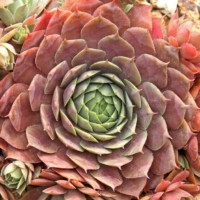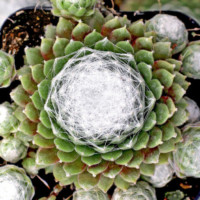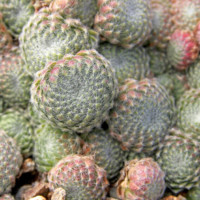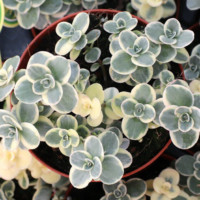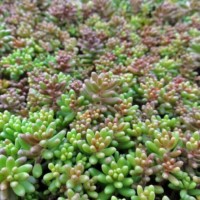This is the 3rd post in our Essentials of Succulent Design series. We’re learning the principles and elements of design while creating simple succulent arrangements with varieties that will thrive in the same growing conditions. In the first post, we created a succulent arrangement for partial sun focused on the design principle repetition. Next, we created an indoor arrangement focused on contrast. Today, we’re using hardy succulents that thrive in full sun year-round in cold winter climates down to zone 5 (-20° F / -29°C). And the design principle we’ll focus on for the succulents design is emphasis. Of course, you’re welcome to jump straight to the MCG Succulent Trifecta Kit™ based on my design. Or read on to learn how I chose the plants and placed them to create emphasis. At the end of this post, you’ll find 45 additional cold hardy succulent varieties I recommend for creating your own hardy succulents design!
Hardy Succulents Design
In this Post We'll Cover:
{Please note, some links in this post may be affiliate links to sites that pay me a small commission if you click on the link and make a purchase. This commission is at absolutely no cost to you. I only recommend products and companies that I have worked with and truly love! ~Kat}
Succulents Design Principle Emphasis

When we discuss the Principles and Elements of Succulents Design, we are applying the same strategies of design used in interior decorating, floral design, website design, graphic design and more to the arrangement of succulent plants. Emphasis is the design principle used to draw the viewer’s attention to a specific part of the design. It creates the focal point of the design. In order to create emphasis, you might use design elements like color, shapes, textures and mass. And you might employ other design principles like balance, proximity, repetition or contrast to create emphasis. Remember, design elements are the inherent qualities of the plants, pots and top dressings or other items you design with, like color, texture and shape. Design principles are the judgments you, the designer make in your selection and placement of the items you use.
In the photo above, your eye goes right to the bed, doesn’t it? There are many elements, big and small in this design. But the designer emphasiszed the bed to make it the focal point. This was done in several ways. First, the bed and the area rug that frames it are from the same, slate blue, the richest, most saturated color in the room. Color is an effective way to create emphasis. Scale is another tool for creating emphasis — the bed and area rug are the largest masses in the room, by far. Balance and alignment are also useful for creating emphasis. See how the designer has created tremendous symmetry in the wall behind the bed, with the bed at the exact center? While asymmetry can also be used to create emphasis, this is an excellent example of the use of symmetry.

When working with hardy succulents, let’s see how plant choice, color, scale and placement can be used to create emphasis in a succulents design.
Creating a Hardy Succulents Design with Emphasis

As always, I designed this MCG Succulent Trifecta using a Core, a Complement and a Character. (For an in-depth review of this design approach, please read Introducing Essentials of Succulent Design.) The large, gorgeous pink Sempervivum ‘Zulu’ was the Core or the heart of the design, and the focus. ‘Zulu’ changes color several times throughout the year, and each one’s goI chose the cobwebbed Sempervivum arachnoideum ‘Cebenese’, with its bright, apple green color and pure white filaments to serve as the Complement, where it enhances and brings out the best in the Core. As lovely as the Zulu is on her own, I feel the contrast with the lively green Cebenese really makes the pink color sing. And the perfection of Zulu’s rosette is highlighted by Cebenese’s cobwebbed rosettes. Finally, the silvery Sedum cauticola ‘Lidakense‘ adds whimsy and texture as the Character. With cold, the silver becomes whiter and tinged with rose. Lovely!
Do you see how the color and the scale of Sempervivum ‘Zulu’ really stands out in this hardy succulents design? The bright, rich pink shades attract the eye, while the green, white and silver of the other plants make a nice background. This is using color to create emphasis. And it is much larger than the other plants in the arrangement, so the scale, too, emphasizes the focal point. When I planted the three hardy succulents together, I placed the Core plant, Sempervivum ‘Zulu’ close to the edge of the pot, so the rosette would extend well past the edge of the pot, while reaching inward past the mid-point. Then, by showing the arrangement with the ‘Zulu’ firmly in the foreground, the placement also further emphasizes the focus point.
There are a number of techniques that can be used in succulents design to create emphasis. When you’re starting out, choosing a large, brightly colored Core succulent and pairing it with smaller, neutral-colored Complement and Character plants is the simplest way to create emphasis. This hardy succulents design was the inspiration for the MCG Succulent Trifecta Kit™ Strawberry and Ice.
Caring for a Hardy Succulents Design

As is true for all the succulent arrangements I’ll describe in this series, all of the varieties chosen for this hardy succulents design will thrive together in the same lighting, watering and climate. These succulents, and the 45 cold hardy varieties listed below, grow best outdoors in full to partial sun. Although the Sedum is hardy to zone 4, the two Sempervivum are hardy just to zone 5, so as an arrangement, the group is hardy to zone 5 (-20° F / -29°C) if you plant it in the ground. If you plant your hardy succulents design in a container, plan for it to be hardy to zone 6 (-10° F / -23°C) because potted plants experience a full zone colder in winter than do plants growing in the ground.
There’s an additional consideration about cold hardy Sedum I’d like to cover here. If you elect to overwinter your hardy succulents arrangement indoors, the hardy Sedum are going to stretch. No matter how much light you provide indoors, hardy Sedum are likely to etiolate. Sempervivum can grow indoors without stretching, but the hardy Sedum are unlikely to. So, if you cannot leave your hardy succulents design outdoors over the winter, consider skipping the Sedum, or plan to cut it back and re-root it in the spring.
Best Succulents for a Hardy Succulents Design
The following are 45 succulents I recommend for creating your own hardy succulents design. Of course, there are many, many (many) more hardy succulents to choose from. But all of these will thrive in the same conditions, and fit this design theme and hardiness zone 5. I have divided them into Core, Complement and Character. The varieties I have chosen for the Core are large, colorful Sempervivum that remain brightly colored throughout most of the year.
Core Succulents for Full Sun, Hardy to Zone 5
The Core is the heart of your hardy succulents design, the focus point. This is the succulent the entire arrangement is designed around.
Complement Succulents for Full Sun, Hardy to Zone 5
The Complement is chosen for its ability to enhance the beauty of the Core succulent. In fact, to complement it. I really love the look of a cobweb Sempervivum complementing a large, pink variety.
Character Succulents for Full Sun, Hardy to Zone 5
The Character adds a sense of whimsy with a new texture or an intriguing shape. Hardy Sedum offer a wide range of textures that are fun to play with in an arrangement.
This was the third in the series Essentials of Succulent Design. This may be my favorite of these trio designs. The Sempervivum ‘Zulu’ is just fabulous, isn’t it? And I love the way the “chicks” tumble over the side of the pot! That apple-green cobweb semp, too, is marvelous! Take care not to get any loose soil in the filaments of a cobweb Sempervivum — it’s time-consuming to clean it out without tearing the charming cobwebs!
I really hope you’re finding the information useful! I’d love to hear what you think! Does the Core, Complement and Character make sense to you? Is anything unclear? I would welcome any suggestions or recommendations that would make this design series clearer! Just leave me a comment, and I’ll get right back to you! The next arrangement we’ll cover is another for full sun, this time using soft succulents. And we’ll be looking at color theory!
Because life is just better with succulents!
P.S. For more information on succulent design, care and crafts, please subscribe! I’ll send you my FREE e-course, 7 Steps to Succulent Success! Thanks!
P.P.S. Why not join my Facebook Group for succulent lovers? We talk about succulent care, propagation, succulent identification, and design. It’s a warm and welcoming group that would love to meet you!
P.P.S. Why not join my Facebook Group for succulent-lovers? We talk succulent care, propagation, identification and design. It’s a warm and welcoming group that would love to meet you!


